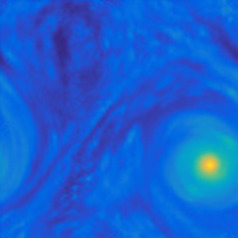Muller and Romps, Acceleration of tropical cyclogenesis by self-aggregation feedbacks, PNAS, 2018
Paper
Description
In high-resolution numerical simulations of the convecting atmosphere, the clouds sometimes clump together into a single blob of intense convection. This phenomenon is referred to as convective aggregation, or convective self-aggregation. Strictly speaking, convective aggregation does not occur in nature: the atmosphere does not collapse all of its convection into a single patch. But, perhaps the feedbacks that are responsible for aggregation in simulations are important for the organization of convection in the real world.
This paper explores the degree to which self-aggregation feedbacks (radiative and surface-flux feedbacks) are important for tropical cyclogenesis. It turns out that the radiative feedbacks are strong enough that they accelerate tropical cyclogenesis by a factor of two or three. In fact, the radiative feedbacks are so strong that the atmosphere can spin up a tropical cyclone with radiative feedbacks alone, i.e., without wind-induced surface heat exchange (WISHE).
Even without interactive surface fluxes (i.e., fluxes that are larger where the wind speed is higher), tropical cyclogenesis is still possible so long as there is interactive radiation (i.e., radiative heating a function of the water vapor and cloudiness of the atmospheric column).
